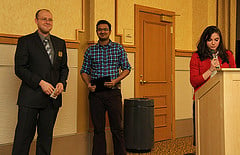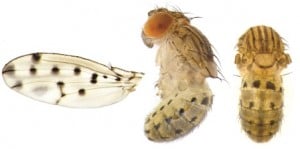The Ecosystem Science Center and the Biotechnology Research Center announce award recipients of the Tenth Annual ESC/BRC Student Research Forum held March 19. 60 posters presented
Graduate Research
$100 Merit Awards
Biotechnology Research Center
Yiping Mao (Bio Sci) for “Overexpression of microRNA-30d increases insulin biosynthesis and protects against high-fat diet induced glucose intolerances,” Advisor Xiaoqing Tang.
Ecosystem Science Center
Cameron Goble (Bio Sci) for “Assessment of Fish Communities in Tributary Streams of the Big Manistee,” Advisor: Nancy Auer.
Other award Department’s award winners are highlighted in “Tech Today.”
 Oral Presentation Award Winner: Morton Harwood from the Department of Biological Sciences was awarded the first place presentation award at the
Oral Presentation Award Winner: Morton Harwood from the Department of Biological Sciences was awarded the first place presentation award at the 

